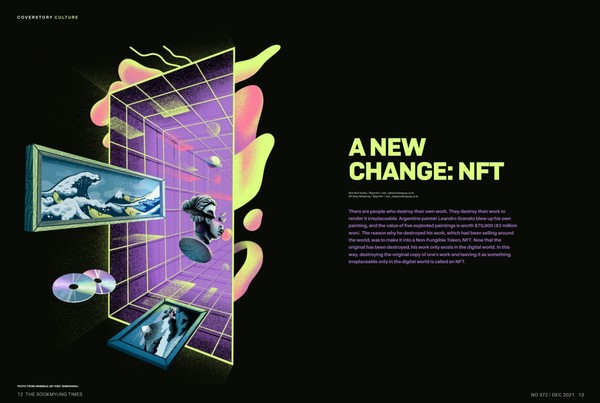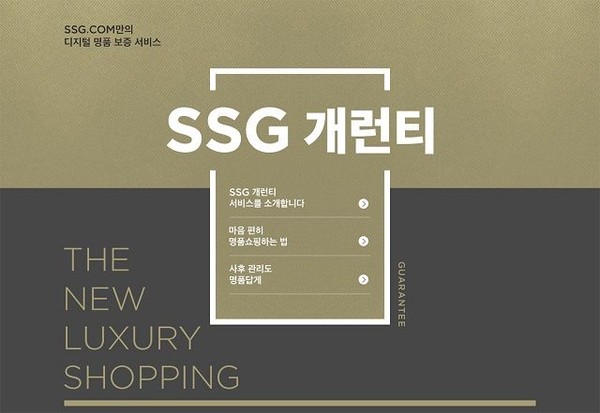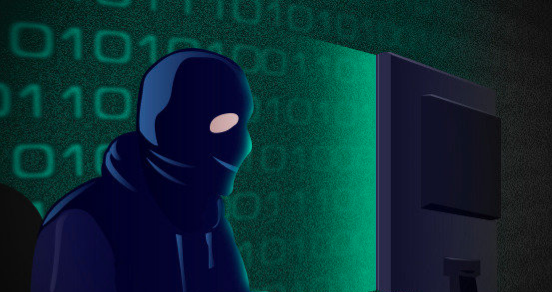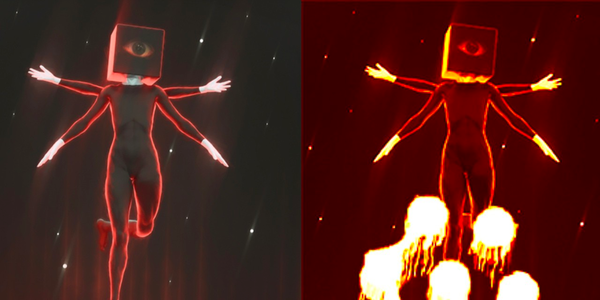
There are people who destroy their own work. They destroy their work to render it irreplaceable. Argentine painter Leandro Granato blew up his own painting, and the value of five exploded paintings is worth $70,000 (83 million won). The reason why he destroyed his work, which had been selling around the world, was to make it into a Non-Fungible Token, NFT. Now that the original has been destroyed, his work only exists in the digital world. In this way, destroying the original copy of one's work and leaving it as something irreplaceable only in the digital world is called an NFT.
Expansion of NFT
NFT stands for "Non-Fungible Token" and is the only irreplaceable digital asset produced using the blockchain network, a trust-based network. In the virtual world, all information related to products, such as ownership and sales history, can be stored in the blockchain and the first issuer can be identified, making forgery impossible. There are millions of NFTs in the world, and their types and values vary widely. And NFTs cannot exist as a "digital certificate." As copies increase, the value of an NFT increases as the scarcity of the original file increases. This is why an NFT is called an "irreplaceable" token. According to a report by NonFungible.com, an NFT analysis website, the NFT market has increased eight times in two years as of 2020. In particular, it grew to $338.03 million(4027.52 million won) in 2020, compared to about $40.96 million(48.49664 billion won) in 2018. As such, the NFT market is growing further with the emergence of Metaverse, an environment where not only is NFT mainly traded, but also blockchain and virtual currency are trading means.
In addition, NFTs are easier to issue and manage than existing electronic documents with similar roles. This is because as public interest in NFTs began in earnest overseas last year, many platforms were created for non-experts to produce or trade NFTs on the web. The most representative NFT market is OpenSea, and in Korea, there is "KrafterSpace" developed by Ground X. Using these platforms, NFTs can be created and distributed within a few minutes. It is also free to purchase or resell NFTs issued by others. The transaction is mainly paid by Ethereum, a cryptocurrency. NFT transactions are largely made in the form of an "auction" and "fixed price sales." When the auction is opened, bidding starts at the lowest price, and those who want to make a purchase raise the price. It is generally used when one NFT is issued. At this time, the ownership of the file is given to the person who bid the highest price within the deadline. In this case, prices are likely to rise exponentially. On the other hand, "fixed price sales" is a system in which sellers set prices in advance and raise them. This transaction method is mainly applied when producing multiple NFTs. In this case, a single file is produced in multiple editions and sold with different unique numbers, so it can be purchased at a relatively low price. As such, the NFTs, which can be easily issued and distributed in various ways while ensuring its authenticity, is recognized for its potential. The fields and applications of NFTs are endless.

Everywhere in daily life
NFTs are showing rapid growth, centering on digital and real artworks. Anything that can be digitally recorded in any form, such as music, image, video, or text, can be an NFT. Creators who are having difficulty displaying their works offline due to COVID-19 are attempting to communicate with people by presenting their works through NFTs, a new means. Accordingly, the demand for innovation in the art industry is increasing. And related industries are preparing and applying new payment systems and big data to create and manage NFTs. NFT artworks have joined the mainstream art industry as world-class art auction companies such as Christie's and Sotheby's have launched NFT auctions. Various platforms have also emerged that select excellent works and trade them through NFTs. A representative project is "art blocks." This is the second largest NFT project ever with a cumulative transaction amount of $910 million. NFT services are also spreading in Korea. Ground X, a subsidiary of Kakao's blockchain technology, introduced "Klip Drops," which displayed and distributed limited digital works in Kakao Talk's virtual wallet "Klip" in July. It selected 24 top Korean artists and held a special open exhibition to sell their works publicly and drew much attention because actor Ha Jungwoo's digital artwork was featured. Almost all the works were sold for about twice the starting price at the beginning of the auction. NFT services in the art world are expected to continue to expand in the future.
Meanwhile, the distribution industry is also strengthening customer management using NFTs. In particular, the performance in the luxury industry, where guarantees are important, stands out. Shinsegae Group's integrated online shopping mall "SSG.com" has begun operating an "SSG warranty" service that issues digital guarantees for luxury goods based on Clayton, Ground X's blockchain platform. Instead of the guarantees which were previously provided with paper or plastic cards, guarantees can be viewed on Klip. The warranty contains serial numbers, product information, purchase history, and a warranty period unique to each product, and cannot be reproduced, forged, or altered. Due to this uniqueness, not only luxury brands but also sneakers, a common product on the resell market, have entered the NFT industry. Despite not being able to wear digital sneakers in reality, companies aimed at the MZ generation, which only values scarcity and opens their wallets to buy sneakers, have emerged. The resell platform "Dunk" provides users with NFT limited edition sneakers, with the transactions registered in Dunk through Ethereum, a virtual currency. If the buyer registers the bid through Ethereum and the seller approves it, the buyer's Ethereum transfers to the seller. An official in the distribution industry said, "The online luxury market is growing rapidly, especially among the MZ generation who are familiar with online shopping. In line with this, e-commerce in Korea is also making efforts to reduce the anxiety factors of customers by introducing luxury guarantees."1) As the generation of main consumers changes, companies' sales methods are also changing.
Since then, NFTs have been moving in a more popular direction such as media/broadcasting. MBC sold some of its famous program clips, such as "Infinite Challenge" and "Newstem," and Theta Blockchain provided limited edition NFTs to users who watched a live broadcast commemorating NASA's spacecraft landing on Mars. Even in July, the Kansong Museum of Art, which owns the "Hunminjeongeum Haerye," drew attention by announcing its plan to sell the aforementioned as a limited edition NFT in July. Such NFTs are often unrelated to the actual product and content ownership. Nevertheless, consumers purchase them as a symbol of possession or as a means of demonstrating their "fan sentiment." In other words, the area of NFTs is expanding to a kind of "digital goods." Furthermore, it is also moving into the realm of K-pop. HYBE, the corporation behind BTS, and Dunamu, the operator of Upbit, a virtual asset exchange, have signed an agreement to issue BTS' goods as NFTs. If BTS content and goods, in demand around the world, are issued as NFTs, they cannot be reproduced, which in essence means owning "limited edition goods." An entertainment industry official said, "There is no theoretical limit to content that can be made with NFTs, so not only music but also content related to portrait rights such as photocards and various records and traces of stars can be made into assets. Fans tend to go especially crazy for limited edition goods, so by purchasing NFT goods, they can prove their ownership and resell them later, so I think it is profitable."2) Fans are expected to respond greatly to the advantage of having their own limited special content and goods.

Actor Ha Jung Woo's NFT work sold for 57.1 million won

Still a long way to go
Although NFTs are being used in various fields, there are still problems to be solved. ArtStation, one of the most famous platforms that can share and search for artworks, announced that it would publish several works as NFTs, but they soon withdrew their prepared NFT plans due to mounting criticism over environmental pollution issues. As such, NFTs have drawn concerns about their carbon footprint generated during mining. According to Digiconomist, a website that studies unintended consequences of digital trends, Ethereum, which provides NFTs, produces an estimated 37.29kg of carbon footprint in a single transaction. This is the same as 82,648 VISA transactions or the carbon footprint of 6,215 hours of YouTube viewing time.3) The carbon footprint comes from the consensus mechanism built by the leading blockchain in NFTs. Since an NFT emits carbon dioxide whenever it is generated or traded, it is impossible to determine the exact number of emissions. So, carbon offset rights are being discussed as a solution to NFTs' environmental problems. A carbon offset is an amount paid to fund projects that lower carbon emissions or remove carbon dioxide from the atmosphere. NFT Marketplace Nifty Gateway announced that it would purchase carbon offsets equivalent to emissions to mitigate the negative impacts on the environment. The co-founder of Nifty Gateway said they would purchase carbon offset rights at the end of each month, twice as much as carbon emissions.
Along with environmental problems caused by NFTs, security safety can also be a problem. It was believed that NFTs could effectively prevent forgery and alteration. However, as artists and collectors are unfamiliar with virtual asset technology and the NFT market, more and more scammers and hackers are exploiting security defects in the rapidly growing market. One of the functions of NFTs is that token ownership and sales information are recorded on the blockchain and can be easily tracked, making forgery and alteration difficult. However, another feature of blockchains called "decentralization" makes it difficult to grasp the size and scope of fraud. To prove the weakness of the security, a digital artist created a copy of the most expensive NFT sold at Christie. Some sites put the fake work up for sale. After blocking the sale of copies, he said, "The purpose was to warn of security defects in the NFT system." "Hackers are flocking to digital art as many people unfamiliar with technology suddenly start creating and trading NFTs," and "Collectors pay attention to great digital art, but bad hackers pay attention to security defects," said Max Heiner, director of threat tracking at British cybersecurity firm DarkTraces.4) Many people are interested in the sudden development of NFTs, but the defects are also drawing attention. The industry is also working on countermeasures. Deviant Art, an online community that provides mostly free samples of works by digital artists, introduced AI software last month to prevent unauthorized resale of NFTs and warns artists if they have any doubts. Some artists are also hiring blockchain authentication providers and issuing genuine certificates.
Along with security issues and environmental issues, another problem with NFTs currently being discussed is the infringement of intellectual property rights. Wannabe International, a comprehensive advertising agency, said it would auction NFTs of three deceased artists' works, but their bereaved families who own the copyright said they never agreed. This was controversial because the copyright and ownership of the work are different. Holders who are not copyright holders cannot turn the work into NFTs. Since NFTs cannot be made, it is impossible to auction them from the beginning. In response, a copyright expert said, "There is no problem for the author to make and sell his work as an NFT. However, it can be a problem if he does it to others' works, but there is no NFT copyright-related system yet, so we need to pay attention."5) The problem of copyright transactions through digital assets is an issue that should be comprehensively considered not only in harmony with the existing system, but also in connection with other blockchain technology policies. To this end, the Ministry of Culture, Sports and Tourism said it would form a discussion body composed of academia and field experts to collect opinions through "research on copyright law improvement measures to respond to technological changes such as artificial intelligence and databases" conducted by the Korea Copyright Commission. In addition, the government plans to cooperate with copyright organizations, art organizations, business operators, and experts to investigate and continuously monitor the scale of infringement. If there is room for NFT-based creations to infringe copyrights, such as the right to reproduce the original work, it plans to actively respond by investigating whether copyright infringement is violated in connection with the copyright holder.


'The Wizard' (left) produced by Eva Milka, an imitation that appeared as a plagiarism work (right)
The way we look at NFT
The irreplaceable NFT is used in many fields. It is used not only in the art field but also in the distribution and logistics industries. Although it is expected to be used in more and more diverse fields, there are still problems to be solved just like the introduction of any new technology. There are problems that must be considered, such as environmental issues, security issues, and intellectual property rights issues. Nevertheless, the economic value of NFTs is soaring, and attention should be paid to the changing world of NFTs.
1) Hong Jiin, "[Style] "Let's Buy Luxury Goods With One Touch"...Online Luxury Market Expansion", Korea Finance, October 2, 2021
2) Jeong Minha, ""Can't Forge" Buy Your Own Idol Content… Entertainment Industry That Opened Its Eyes to NFT", Chosun Biz, August 16, 2021
3) Director of the China Securities Administration Research Institute, "NFT and Carbon Emissions", The Yeongnam Ilbo, September 7, 2021
4) Bae Junho, "Warning Issued to the NFT Market…Fraud and Hacking Hotbed", Etoday, September 4, 2021
5) An Hocheon, "The Spread of NFT and Growing Copyright Concerns", Etnews, June 29, 2021
Kim Seol Yunha / Reporter
smt_syh@sookmyung.ac.kr
Oh Song Minyeong / Reporter
smt_smy@sookmyung.ac.kr


